Clint Chase of Chase Small Craft wrote of his Drake Raceboat: “This was the first boat that I designed totally from the numbers.” It’s the third in his series of Drake Row Boats and, at 18′3″, it fits in between the Drake 17 (17′4″) and the Drake 19 (19′2″). While the Drake Raceboat has a familial resemblance to these two American-born relatives, I suspect that there is some Finnish blood in its veins. The fine entry, the ‘midship cross section as close to semicircular as you can get with four wide strakes, and the light laminated frames look a lot like they came from the boats Finns use for racing on their vast network of interconnected lakes. With no keel and very little deadrise to the garboards, the Raceboat won't roll on its side when resting on a beach.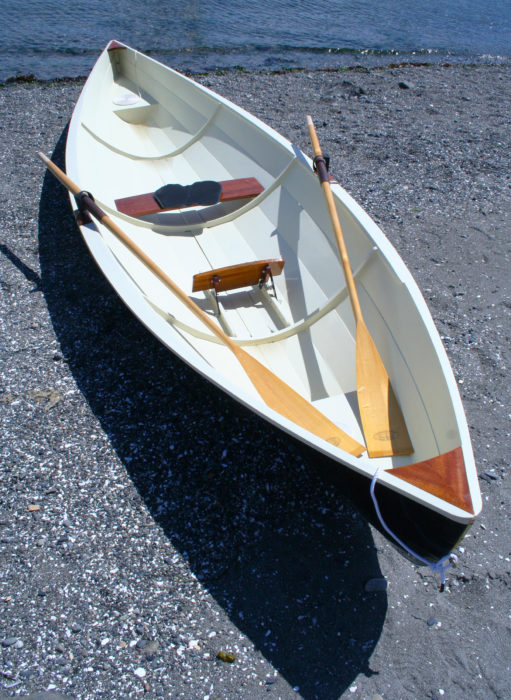 Christopher Cunningham
Christopher Cunningham
Join The Conversation
We welcome your comments about this article. To include a photo with your remarks, click Choose File below the Comment box.

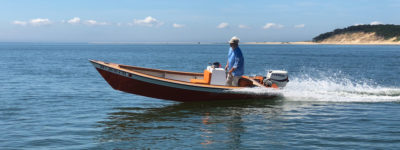

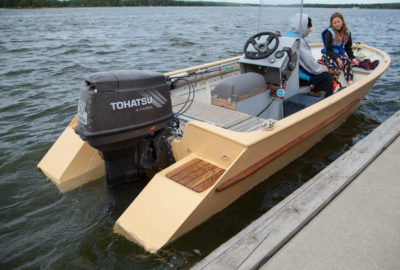
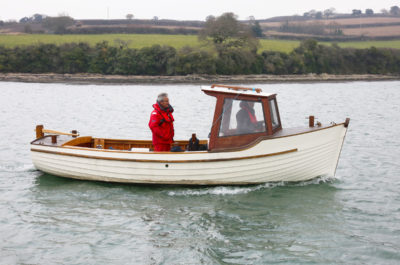
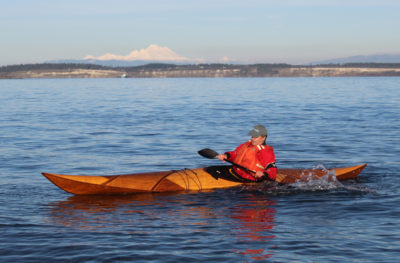
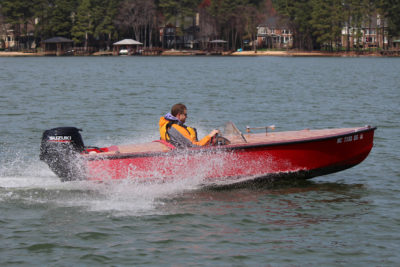
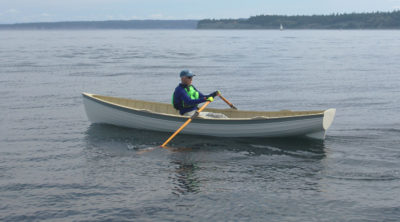


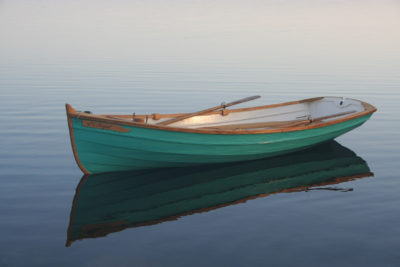

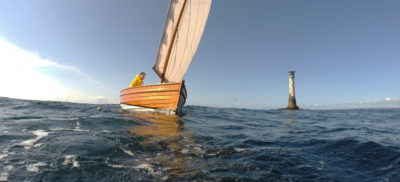
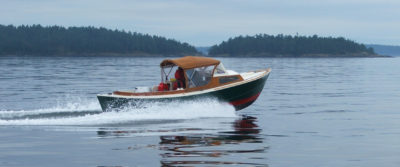

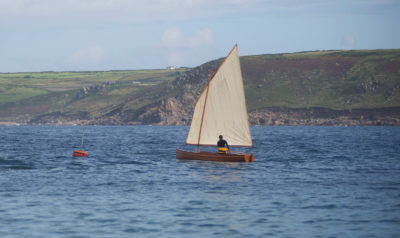
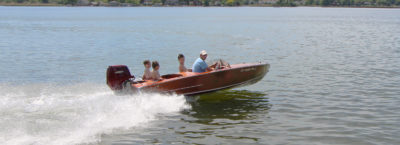
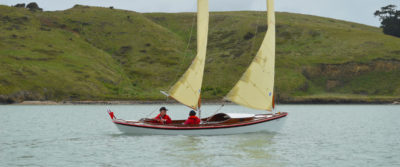
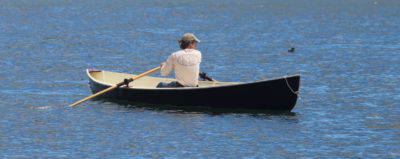
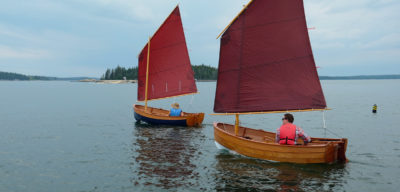

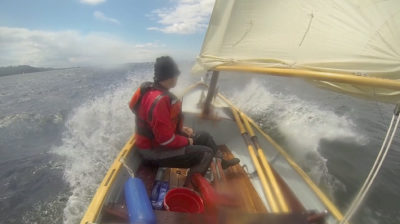

It is good to see new design ideas coming out like this. Of course we would worry about its tenderness but the same complaints are made about the Adirondack guide boat. I always advise customers to hold onto the gunwale on boarding as overbalancing is the only way of falling in. My studies indicate that for cruising a waterline length of 16′ or less is best to reduce wetted surface. Since we cruise at about 4 knots, wave making does not cause much resistance compared with boat friction in the water. I am inclined to think a smaller person or a female might cruise more easily with a 15′ boat. By the way we race around Dangar Island in Sydney and the best speed for the event in a Herreshoff rowboat (16’5″ waterline length) is 5.6 knots.
Yet another example of a beautiful boat designed by a talented Clint Chase. I love his use of new methods (CNC) and techniques (three-step scarf) to produce timeless designs with a classic look. Keep up the good work!
Thanks, Jim. And thanks to Mr. Tolpin and Mr. Lind for really building a beautiful prototype. Thank you Chris for putting this review together.
There is also a 20′ set of lines prepared for kitting, as requested by a gent in the SF Bay area. I think that will go like smoke, too.
The boat is beautiful but the oars, to give it justice, should be of the spoon type. Of course these may have just been just to hand for the photos. However I also notice that the gap between the handles inboard seems to be larger than would be proper. I also believe it more proper that the oars should be drawn inboard to stow rather than swinging the blades to sit on the seat depositing water. “Efficient rowing” is discussed in detail on my website along with articles on rowboat design and making an oar. I hope this little contribution has been helpful.
We had several pairs of oars available when I rowed the Raceboat.Two would fit the Gaco locks that the boat was equipped with. One pair
We had several pairs of oars available when I rowed the Raceboat. Two pairs fit the Gaco locks that the boat was equipped with. One pair, which appears in the photos without leathers, was about 7′ 9″ in length with blades that were beyond spooned. They were “cupped” and hollow between the blade edges. I didn’t care much for the length or the blade shape. The following day, Tom Regan of Grapeview Point Boat Works brought a pair of 8′ spoons. They appear in the photos as the pair with leathers. We reviewed his oars in October 2015 issue. Clint Chase designed the boat to be rowed with 8′ 6″ oars. The 8-footers worked well, but 8′ 6″ oars would have given me the inboard length that I prefer and that John advises in his comment.
I found this article to be very interesting as I am always looking to try a new rowing boat. This is a decent looking craft. I found the oar talk interesting also as I’m looking for another set of oars for my Seaford Skiff. The tenderness they mention reminds me of the Alden I had. I don’t use a floating dock.
Very interesting article. Boat is definitely a good looker. The tenderness worries me also as I get in my Seaford Skiff from the dock, not a floating dock. I am contemplating another set of oars and contacted Pete at Adirondack Rowing.
One way that I board tippy boats is over the end. Sounds a little weird, but it is basically crawling into the boat.Bend over the end, slide the hands down the boat as far as you can then dive, in staying as low as you can. Works best if you have a deck in the end like my ducker or a bow seat like my dory. I think someone showed me this launching a guideboat from a boat-house ramp. You push the boat off the ramp at the same time.
A variant on Ben Fuller’s bow-boarding technique was developed on the spur of the moment by my exuberant five-year-old (now fifteen years ago) in a canoe on the Concord River in Concord, Massachusetts.
It wasn’t in a tender boat, I grant, because the canoe was already well-ballasted by having me in the stern. We’d beached it, square to the shore, and then when it was time to go, son Tom said he wanted to be the one who shoved us off.
So I climbed in (canoe still hard aground) and made my way to the stern seat without incident—which did unweight the bow enough that Tom could move it easily, and then it was Tom’s turn.
He gave a tremendous shove until he was in shin-deep water, and then flung himself bodily crosswise over the bow where it was no more than 1′ wide, so about 18″ of him dangled out over water in each direction. Then, as we glided briskly on out into the deep middle of the river, he sorted himself out parallel within the hull and took his seat.
Looks good, but I’d like such a light boat as this to also be able to rig for sail.
I’ve rowed the DRB 18 quite a bit, and then built the larger DRB 20 this past spring. In my experience, the tenderness is a benefit in feel without being a nuisance in practice. You can easily slide the oars in, rock back and forth, and not get close to submerging a gunwale. The secondary stability is really impressive, and part of what makes this boat such a great “both/and” solution. And the thick rails mean that waves, wakes, and splashes are almost never a concern – even in 15 to 20 knots with stacked seas.
Like Ben, I usually enter from the bow and just walk up the keel with my hands on the gunwales, but I have entered from the beam and it’s no problem. My boat has large outriggers, which makes docks challenging, but with standard gunwale-mounted or folding oarlocks, I don’t think it would be a problem.
Bottom line, I love these boats. I’m extremely pleased with my sliding-seat DRB 20, but the fixed-seat DRB18 is a treat in its simplicity and effortless speed.
Wonderful accomplishment, Nate.
That secondary stability was quite striking to me, too, one day when I was given a traditional Norwegian 19′ fearing, with sprit sail, to play with in Oslo Fjord. It had a similar quarter-circle frame section amidships, and when you’d begin to roll it, the whole lower side would just lie down on the water, and it wouldn’t roll further.
I had spent a lot of time in Tech Dinghies, which handle delightfully but are relatively bathtub-shaped in section, and if you’ve rolled them far enough for a rail to approach the water, you’re courting a capsize. But in this thing, the harder I pushed it the stiffer It got. I could go barging along with the rail only 3″ off the water and not even worry about it.
Clint Chase: “This was the first boat that I designed totally from the numbers.”
Does this mean that you numerically designed the boat before creating drawings? Is this a purely mathematical technique, or are you using “numbers” derived from algorithms in a computer program? Your Drake raceboat is obviously well thought out; a very smooth, continuously curved multi-chine design.
I routinely use a technique based on mathematical equations which I started in the early ’70s, before programs were available, but have not read of anyone else using a similar approach. Of course, for me it is purely a hobby. I enjoy the accuracy of perfectly fair curves. Now building my 12th design.
Some observations about rowing: Years ago, I was rowing a Bolger Light Dory on Bellingham Bay against a stiff breeze–probably 12 knots, with plenty of whitecaps. I was in company with a Row Cat–a catamaran with a sliding seat and very skinny hulls. Having recently read Bolger’s comments about rowing against sea and wind, I was using a short, quick stroke, and was able to stay with the Row Cat over several hundred yards. I was also handicapped by the ill-fitting department-store oars on the dory, as they were much too short.
I have come to doubt the benefit of a sliding seat with very long oars. My “reasoning” (yes, I will boldly call it that) goes something like this: If you scull a boat over the stern–wiggling the oar back and forth–you can propel the boat pretty efficiently. All the thrust comes from the water sliding rearward off the end of the blade. In fact, this effect happens with ordinary oars as well, though probably less so with spooned or cupped oars.
With the extra long stroke you get with a sliding seat, the first part of the stroke is going to be accelerating some of the water forward, which will tend to retard the speed of the boat. The effect will vary in intensity up until the oar is at right angles to the centerline of the boat. The desired thrust will build until the oar reaches farthest aft. The sculling principle will be in play throughout the stroke, partly retarding forward progress at first and then augmenting it.
I wonder if anyone has tried sliding-seat rowing by starting the stroke farther back than is usually done.
I have found the same principle to occur in padding a kayak against wind and waves. Beginners tend to take a long powerful stroke (as I did when I was first learning) thinking to muscle the boat through the resistance, which can be considerable In those conditions, I have found a short, quick stroke to be much more efficient, and a lot easier on the body and less tiring. Part of the benefit here comes from the fact that almost continuous thrust results, (I tend to think of it as steady pressure on the kayak) with less time spent (wasted) swinging the paddle through the air to set up for the next stroke.